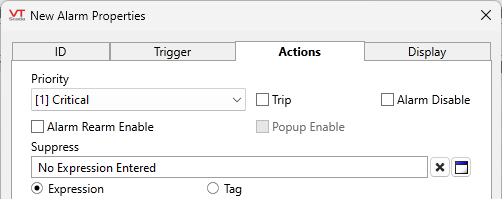
The ability to disable or enable an alarm is controlled by a security privilege that might not have been granted to you. See your VTScada manager.
Disabling or enabling an alarm is a tag configuration change, not an operational change. It cannot be done with the tools in any alarm list.
There may be times when equipment must be taken offline. Rather than have alarms occur as a result, you may prefer to disable the associated alarms. The Alarm Page includes a list of disabled alarms, thus making it easy for you to find all the alarms that need to be re-enabled when the time comes. Procedures at your location may require that alarms be shelved rather than disabled. (Shelve Alarms)
To disable an alarm, use the tag's configuration panel. By design, the option of using an expression is available to alarm suppression but not for alarm disabling. This is in accordance with ISA 18.2: Disabling an alarm is considered a configuration action that should be done explicitly. Alarm suppression can be linked to an expression or tag. The effect is the same but the actions should be tracked independently.

Alarm tag - Actions tab.
Note that either an expression or another tag can be used to disable the alarm
MakeActiveAlarmUnackedWhenEnabled
TRUE to mark an active alarm as unacknowledged when it becomes enabled
RecordAlarmStatusWhileDisabled
TRUE to record the alarm status while an alarm is disabled
Customers who used VTScada prior to the release of this feature might have configured parameter expressions in their I/O & Calculation tags to disable alarms. Those expressions are automatically transferred to alarm suppression as part of the upgrade process.
Comparison: Shelve / Disable / Suppress Alarms
| Feature | Used by | Use to... |
|---|---|---|
| Shelve |
Authorized Operators Available through the user interface. |
Hide and silence an alarm temporarily. |
| Disable |
Developers / Engineers Must be configured in individual alarms. |
Block specific alarms from occurring. For example, the alarm is not currently needed but might become relevant again. |
| Suppress |
Automated Developers set a condition for suppressing one or more alarms using an expression or a tag. If set using a memory tag, authorized operators can suppress the alarms. If set using an expression, alarms can be suppressed automatically. |
Block specific alarms from occurring while a condition is true. For example alarms might be suppressed while related equipment is not running. |
